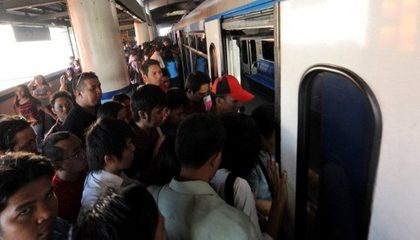SUMMARY
This is AI generated summarization, which may have errors. For context, always refer to the full article.

MANILA, Philippines – Transportation Secretary Mar Roxas took a swipe at Japanese firm Sumitomo Corp., the current operations and maintenance contractor of the MRT Line 3 (MRT-3), for the frequent breakdown of trains and the discomfort of the over half a million daily passengers.
In a press briefing on Monday, March 26, Roxas cited the “weak” O&M (operations and maintenance) contract that binds the government to the services of Sumitomo.
“These are the weaknesses of the old contract, which were negotiated 10 to 15 years ago. So we are now suffering because of the weaknesses of the contract which we can only correct when the new contact is bided out this year,” he said.
He cited as example the minimum number of trains that Sumitomo is required to deploy under the current contract. He said Sumitomo, which is maintaining only 20 train sets, is penalized only if the trains running along the MRT-3 line goes down to 18.
Roxas said this minimum figure is not enough to ferry the current number of passengers taking the high-traffic MRT-3. The rail system is designed to carry at least 350,000 passengers a day though daily traffic peaks at over 500,000.
Bidding in October
Roxas said the lessons from the Sumitomo contract, which will end in October this year, will be considered when his department designs a new contract that will put up for bidding.
“We are working out to impose stricter parameters…When the new contract is in place, the penalties will kick in when the number of trains running are at 20 and below. This means that the new contractor will have to work harder to make the number of MRT trains operational at 20 above,” explained Roxas.
The bidding for the O&M contract of MRT-3 was supposed to be the first infrastructure project bided out under the Aquino government’s public-private partnership program (PPP) in 2011.
When Roxas took over the reigns of the Transportation Department in July 2011, he required a review of the contract, resulting in a delay in the bidding.
Various business groups, including the Pangilinan-led Metro Pacific Investments Corp. (MPIC), Ramon Ang-led San Miguel Corp., and the Ayala group, have expressed interest in participating in the auction.
New trains
A budget has already been set aside for the purchase of new trains to address overcapacity issues but Roxas said the funds could not be disbursed until the legal issue with Pangilinan’s group is resolved.
President Aquino approved the release of P6.3 billion to acquire new coaches. Of the amount, P4.5 billion will be spent to buy 26 coaches for the MRT line 3. The remaining P1.8 billion will be spent for the rehabilitation of LRT line 1.
The 26 additional coaches for MRT-3 are meant to increase its loading capacity by as much as 60% to 37,824 passengers per peak hour in each direction from the current 23,640 passengers per peak hour per direction.
“The government plans to acquire 26 coaches versus MPIC’s (Metro Pacific Investment Corp.) proposal of 73. We need to take a look if the 26 is enough or if we need the entire 73. Also, we have to study the conditions attached to their proposal such as the proposed fare and possible extension of the contract. All of which have to be taken into serious consideration,” said Roxas.
MPIC has been asserting that it has the right to operate, maintain and expand the high-traffic Edsa railway system since it already holds a substantial stake in MRTC (Metro Rail Transit Corp.), the consortium that built the MRT-3.
Roxas, however, said the government is in charge of the MRT-3 since 80% of MRTC’s economic interest is held by state-owned Development Bank of the Philippines and Land Bank of the Philippines.
The state-owned banks’ economic interests also include a 22.3% direct stake in MRTC and MRT bondholdings. – Rappler.com
Add a comment
How does this make you feel?
There are no comments yet. Add your comment to start the conversation.